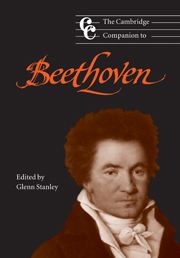Book contents
- Frontmatter
- Part I A professional portrait
- Part II Style and structure
- Part III Genres
- Part IV Reception
- 14 “With a Beethoven-like sublimity”: Beethoven in the works of other composers
- 15 Beethoven's music in performance: historical perspectives
- 16 The four ages of Beethoven: critical reception and the canonic composer
- 17 Beethoven at large: reception in literature, the arts, philosophy, and politics
- Notes
- Selected further reading
- General index
- Index of Beethoven’s compositions and sketches
- Plate section
15 - Beethoven's music in performance: historical perspectives
from Part IV - Reception
Published online by Cambridge University Press: 28 September 2011
- Frontmatter
- Part I A professional portrait
- Part II Style and structure
- Part III Genres
- Part IV Reception
- 14 “With a Beethoven-like sublimity”: Beethoven in the works of other composers
- 15 Beethoven's music in performance: historical perspectives
- 16 The four ages of Beethoven: critical reception and the canonic composer
- 17 Beethoven at large: reception in literature, the arts, philosophy, and politics
- Notes
- Selected further reading
- General index
- Index of Beethoven’s compositions and sketches
- Plate section
Summary
The history of performing Beethoven is in essence the history of our entire Western culture of musical performance as it has evolved since the end of the eighteenth century. One is even tempted to write “Western culture” tout court. The ways in which we have kept alive the creations of one of the most potent icons of our civilization, the written instructions of the printed scores mediated by individual performers and by changing performance conventions, speak eloquently of deeper issues – of cultural value, tradition, authority, the individual and society, written versus oral communication, intuition versus reason. At a more concrete level, Beethoven's music underpinned the formation both of the fundamental performance institutions of modern musical life, including the character and makeup of our public concerts and recitals, and of the very idea of a mass culture of “serious” music that elevates edification over mere entertainment. And from Franz Liszt's use of selected sonatas in the nascent modern piano recital, through to the adoption of Beethoven by the “authentic” performance movement in the 1980s, Beethoven's music has assumed a variety of contrasting symbolic meanings – Romantic rebel, disciplined Classicist, proto-Modernist – all of them heavy with prestige and authority, whether covertly or openly invoked. The attempt to project these meanings has shaped specific decisions about performance practice – the size of performing forces, details of tempo and articulation, the structure of concert programs – and these in turn have influenced the changing images of Beethoven's art.
- Type
- Chapter
- Information
- The Cambridge Companion to Beethoven , pp. 255 - 271Publisher: Cambridge University PressPrint publication year: 2000



